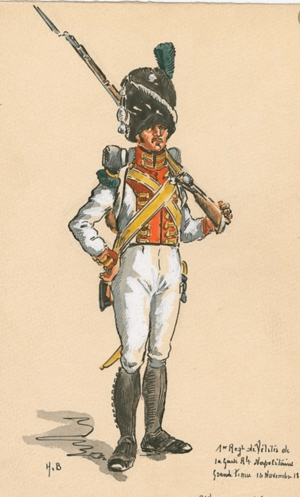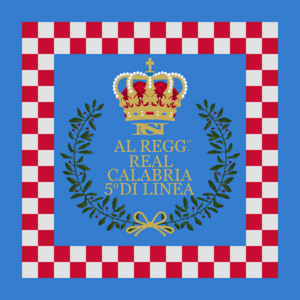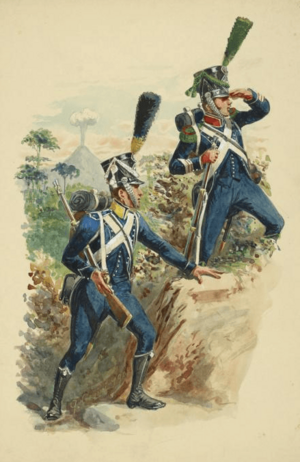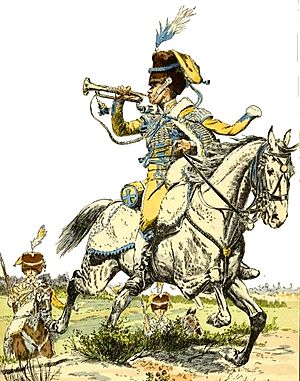Army of the Kingdom of Naples (Napoleonic) facts for kids
Quick facts for kids Royal Neapolitan Army |
|
|---|---|
| Esercito del Regno di Napoli | |
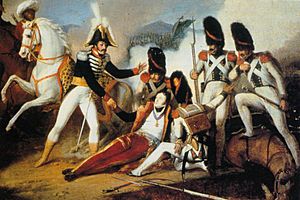
Joachim Murat helps the wounded general Filangieri after the Battle of the Panaro.
|
|
| Active | 1806–1815 |
| Country | |
| Branch | Ground Forces |
| Type | Main Army |
| Size | At-least 47,000 by 1815 |
| Army Headquarters | Naples, Campania, Kingdom of Naples |
| Motto(s) | Onore, e Fedelta Senza Macchia |
| Colors | |
| Engagements | War of the Fourth Coalition War of the Fifth Coalition War of the Sixth Coalition Neapolitan War |
| Commanders | |
| Notable commanders |
Joachim Murat Michele Carrascosa Guglielmo Pepe Pietro Colletta Carlo Filangieri Charles Antoine Manhès Francesco Macdonald |
The Army of the Kingdom of Naples (called Esercito Napoletano in Italian) was the main army of the Kingdom of Naples. This army helped Napoleon in many battles and wars across Europe. It existed from 1806 to 1815. The army was formed after the old Army of the Two Sicilies was taken over. People often remembered this army more for its fancy uniforms than for its battle victories.
Contents
How the Army Started
In 1806, the old Bourbon-ruled Kingdom of Naples changed. Napoleon set up a new French-controlled state. His brother, Joseph Bonaparte, became the new King. Later, Joseph became King of Spain. So, Napoleon gave the throne of Naples to his brother-in-law, Joachim Murat.
The army quickly became the biggest employer in the Kingdom. King Murat wanted to make the army strong and independent. But it was hard to find enough soldiers. People did not like the French system of forcing young men to join the army. At first, so few men joined that even criminals were made to serve. Most officers were either old officers from the previous army or French and Polish officers.
Neapolitan soldiers fought in many battles with Napoleon. They even helped escort Napoleon back to France after the invasion of Russia. However, Murat kept changing sides between 1813 and 1815. This made his army confused and less loyal. Many soldiers lost interest in fighting for him.
What Was the Army Made Of?

Before Murat arrived, Joseph started building the Army of Naples. Joseph was king for only two years. But he laid the groundwork for a modern army, much like Napoleon's famous Grande Armée. The army had two main parts: the Royal Guard and the regular Line regiments.
The Royal Guard was the best part of the army. They were the King's special bodyguards. In 1806, the Guard included Grenadiers, Voltigeurs, and Mounted Velites. The regular army had two Line Infantry regiments and one Light regiment. There were also two Mounted Chasseurs regiments.
Under Murat, the army grew even more. By 1815, it was at its largest. It had two Guard Divisions, 12 Line Infantry Regiments, 4 Line Cavalry Regiments, and 4 Light Infantry Regiments. There were also 40 artillery companies and other smaller units.
The Royal Guard
The Royal Guard of Naples had two sections: Cavalry and Infantry. By 1815, the Guard had two full divisions and many cannons.
When Joseph was king, the Guard was not very big. But when Joachim Murat became king, he made the Guard much larger. Murat loved fancy things, and this showed in the Guard's uniforms. They had lots of gold and fine details.
The Guard's Cavalry started with one regiment of Light Horse (Cavallegieri). These soldiers rode ahead of the army to scout and find supplies. This regiment even escorted Napoleon from Russia in 1812. Murat also created the Mounted Velites from noble bodyguards. They were also light cavalry. In 1808, Murat formed the Guard of Honour. This unit came from soldiers he brought from his old job as Grand Duke of Berg. By 1813, the Velites became Hussars. Later, more cavalry units like Cuirassiers and Lancers were added. This made the Guard Cavalry a full division by 1815.
The Infantry of the Guard in 1806 had Grenadiers and Voltigeurs. The Guard Grenadiers looked like Napoleon's famous Old Guard. They wore tall bearskin hats. Some Grenadier battalions guarded the Royal Palace of Naples. Others fought in Russia in 1812 and the War of the Sixth Coalition. The Voltigeurs were light infantry. They also fought in Russia and returned with Murat. In 1809, two more Velites regiments and a Marine Infantry regiment joined the Guard.
The Guard also had two artillery units. One was for horse artillery, and one for foot artillery. They used French-designed cannons.
Infantry Soldiers
The Neapolitan infantry made up most of the army. They did not get as much praise as the Guard. But their fighting was key to winning battles. Unlike the Guard, infantry soldiers were often forced to join. Few people volunteered at first. King Joseph even let criminals join the army. But these recruits often ran away.
Line Infantry
In 1806, the Line Infantry had two regiments. They were called the "King's Own" and "Queen's" regiments. Each had two fighting battalions and one training battalion. Battalions had six Fusilier companies and two special companies: Voltigeurs and Grenadiers. Grenadiers were the tallest and strongest men. They were used for powerful attacks.
By 1809, there were seven Line Regiments. Each had three fighting battalions. By 1814, there were twelve regiments. These regiments often sent one or two battalions to fight abroad, like in Spain. The other battalions stayed in Naples to train new soldiers.
The 7th Line Regiment was special. It was one of the few units in Europe made mostly of Black people. It started as a French unit. In 1806, it joined the Neapolitan army. It became the 7th Regiment in 1810.
The twelve Line Regiments were:
- 1st Regiment ‘del Re’ (King's Own)
- 2nd Regiment ‘della Regina’ (Queen's)
- 3rd Regiment ‘del Principe Reale’ (Royal Prince's)
- 4th Regiment ‘Real Sannita’ (Royal Samnite)
- 5th Regiment ‘Real Calabria’ (Royal Calabria)
- 6th Regiment ‘Di Napoli’ (Naples)
- 7th Regiment ‘Real Africano’ (Royal African)
- 8th Regiment ‘Principe Luciano’ (Prince Lucien)
- 9th Regiment (Name not available)
- 10th Regiment (Name not available)
- 11th Regiment (Name not available)
- 12th Regiment ‘della Marca’ (Marca)
The special companies (elites) were much better than the regular ones. They believed they were better trained and more experienced. This was often true.
Light Infantry
In 1806, there were two light infantry regiments. By 1813, there were four. Each had two fighting battalions. Battalions had a carabinieri company, a voltigeur company, and seven chasseur companies. There was also a "Royal Corsican" regiment. This unit was made of Corsican people who had left their home. It became the 1st Light Regiment in 1813.
Cavalry Soldiers
The regular cavalry units were mostly Mounted Chasseurs and Chevaulegers. At first, there were two Mounted Chasseurs regiments. By 1813, all regiments became Chevaulegers. A fourth regiment was added in 1814. They started using lances and changed their uniforms. The Line Cavalry mainly did scouting and patrol duties. They were light cavalry units.
There were no heavy Line Cavalry units. Some records mention a heavy cavalry regiment in 1809. But it was destroyed in Spain less than a year later.
Cavalry regiments had 2 to 4 squadrons. Each squadron had 2 to 3 companies. The first squadron usually had the "elite" company. These were like the Grenadiers for infantry. Elite cavalry soldiers wore special hats like bearskins or busbys. Later, some wore czapkas.
Artillery Soldiers
The Neapolitan artillery was not very large. In 1806, there was only one battery of cannons. It had 6-pounder Austrian guns. By the next year, it grew to a regiment of foot artillery. It also had units for supplies, repairs, and engineers. By 1812, there were 12 foot batteries and two horse batteries. Each horse battery had four cannons and two howitzers. Field batteries had six cannons and two howitzers. All were French-designed guns.
Army Ranks
The Neapolitan Army used many different ranks. The ranks for infantry, support units, artillery, and city guards were similar. They were based on the French army ranks. This showed how much France influenced them.
Cavalry units had different ranks than the infantry. But these were also based on the French system. In general, the roles of infantry and cavalry ranks were quite similar.
Infantry Ranks
Here are the main infantry ranks, from highest to lowest:
| Neapolitan Line Infantry Rank | What it's like today (U.S. Army) |
|---|---|
| Tenente Generale | Lieutenant General |
| Maresciallo di Campo | Major General |
| Aiutante di Campo | Aide-de-Camp |
| Colonello | Colonel |
| Maggiore | Major |
| Capo Battaglione | Battalion Chief |
| Capitano | Captain |
| Tenente | First Lieutenant |
| Sottotenente | Sub Lieutenant |
| Aiutante-Sottufficiale | Warrant Officer |
| Sergente-Maggiore | Sergeant Major |
| Sergente | Sergeant |
| Caporale-Furiere | Quartermaster Corporal |
| Caporale | Corporal |
| Soldato | Private |
Of course, the King was the top commander of the entire army.
Cavalry Ranks
The cavalry units had their own ranks. These were also based on French cavalry ranks. Even though the names were different, the jobs of cavalry and infantry ranks were quite similar.
| Neapolitan Cavalry Rank | What it's like today (U.S. Army) |
|---|---|
| Colonello | Colonel |
| Maggiore | Major |
| Capo-Squadrone | Squadron Leader |
| Capitano | Captain |
| Tenente | First Lieutenant |
| Sottotenente | Second Lieutenant |
| Capo-Maresciallo di Casa | Sergeant Major |
| Maresciallo di Casa | Sergeant |
| Brigadiere-Furiere | Quartermaster Corporal |
| Brigadiere | Corporal |
| Cavaliere | Trooper |
Major Battles and Campaigns
Fighting in Spain
In 1808, Napoleon planned to take control of Spain and Portugal. He tricked the Spanish royal family into letting French troops into their country. The Spanish thought they were helping Napoleon invade Portugal. But soon, it was clear that the French wanted to take over all of Spain and Portugal.
Neapolitan troops joined the French army in Catalonia, Spain. On February 29, 1808, Neapolitan soldiers captured the fortress of Barcelona. Similar takeovers happened across Spain. But when the Spanish people heard their king was removed, they fought back. On May 2, 1808, the people of Madrid attacked the French. This started a long and harsh war that lasted until 1814.
French and allied troops faced two big problems in Spain. First, there was not enough food or water. Unlike Central Europe, the Spanish people fought back against soldiers looking for food. Second, there was constant guerrilla warfare. Small groups of Spanish fighters attacked French units all the time. Even small groups of soldiers could be ambushed and killed.
Neapolitan soldiers fought many anti-guerrilla actions in Catalonia. They were ambushed and lost many men on their way to Manresa. A second trip also had many casualties. Later, in June 1808, the Neapolitans helped in the Siege of Girona. But they failed to capture the city. The French general, Duhesme, praised the Neapolitans for their good behavior.
In 1809, the third and final siege of Girona began. The city was captured after a tough fight. Many soldiers died during this siege. In 1810, Neapolitan troops helped block several Spanish fortresses. By 1811, the Neapolitan infantry regiments in Spain were so small they had to combine. They formed the "new" Neapolitan 8th Line Infantry regiment.
Russian and German Campaigns
For the invasion of Russia in 1812, Naples sent about 10,000 soldiers. These included the Marines of the Neapolitan Guard, Velites, and Line Infantry regiments. They were part of the army guarding the city of Danzig (now Gdańsk). After Napoleon's army was defeated in Russia, the Neapolitan cavalry had the honor of escorting Napoleon back to France. They suffered many losses due to the cold weather.
In 1813, the best Neapolitan soldiers from Danzig formed the Neapolitan Elite Regiment. They fought in battles like Lutzen and Bautzen. They suffered heavy losses. Napoleon himself praised these Neapolitan troops. He even gave them awards. He said, "I used to think little of Neapolitan troops. They amazed me in Lutzen, in Bautzen, in Danzig and in Hanau. Their ancestors, the famous Samnites, would not have fought with greater valor."
The Neapolitan units left in Danzig had to defend the city. They faced a much larger Prussian and Russian army. The city was under siege for almost a year. The Neapolitans faced cold, hunger, sickness, and constant enemy attacks. When the city finally surrendered in December 1813, the Neapolitan survivors were taken prisoner. But when their captors heard that King Murat had joined the allies, they were released. They marched back to Naples in good order. King Joachim Murat rewarded these survivors by moving them to the Guard.
Italian Campaigns 1814-1815
King Joachim Murat left Napoleon's side after the Battle of Leipzig. He returned to Naples. He made a deal with the allies: he would keep his throne if he sent 30,000 troops to help them in Northern Italy. But he was slow to act. His Austrian allies had to push him to attack the French-Italians. The Neapolitans won a small battle at the River Taro. This ended the fighting in Northern Italy. Napoleon then gave up his power. Murat kept his throne.
In 1815, news reached Naples that Napoleon had returned to France. Murat decided to break his alliance with the allies. He rejoined Napoleon's side. He marched north with a large army to fight the Austrians. On April 4, the Neapolitans crossed the Panaro river. They defeated the Austrians at Modena.
On April 7, Murat tried to cross the River Po. But he met strong resistance and had to retreat. The Neapolitans suffered many losses. This made Murat's soldiers lose hope. Many soldiers simply left the army. Soon, Murat heard that Britain had declared war on him. The Neapolitans lost more battles and retreated. They finally stopped at Tolentino. The Austrian army arrived there, and it was clear a big battle would happen.
The Battle of Tolentino
The Austrian commander, Bianchi, had about 11,000 men and 28 cannons. Murat had more soldiers: 15,000 infantry, 2,000 cavalry, and 35 cannons. Bianchi knew he was outnumbered but decided to fight. The town of Tolentino had old walls. The area around it was hilly.
Murat sent some troops to slow down another Austrian force. But he soon learned these troops were defeated. At Tolentino, the Neapolitan troops started well. But Murat made a mistake. He ordered his advancing soldiers into large squares. These formations were good against cavalry, but not against cannons. Bianchi quickly used his cannons to fire into the squares. Then, his cavalry charged into the gaps. The Neapolitan advance broke, and they ran away.
Murat's army fell apart. They retreated at night and became a confused crowd. The battle was a huge blow to Murat's army. On May 20, peace talks began. Neapolitan generals signed the Treaty of Casalanza. On May 23, the Austrian armies entered Naples. They put Ferdinand back on the throne.
Meanwhile, Murat escaped Naples. He tried to reclaim his kingdom but was caught. He was executed on October 13, 1815. Most Neapolitan fortresses surrendered after the peace treaty. But General Begani, commanding the fortress of Gaeta, refused to give up. He only surrendered on August 5, after being attacked by many armies. This was the last fighting of the Napoleonic wars.
Images for kids


